
Henry Jenkins gives a fascinating account of an ongoing controversy occurring in a MMORPG in the People’s Republic of China, the fastest growing market for these online games. Operated by Netease, Fantasy Westward Journey (FWJ) has 22 million users, with an average of over 400,000 concurrent players. Last month, game administrators locked down the account of an extremely high ranking character, for having an anti-Japanese name, as well as leading a 700 member guild with a similarly offensive name. The character would be “jailed” and his guild would be dissolved unless he changed his character and guild’s name. The player didn’t back down and went public with accusations of ulterior motives by Netease. Rumors flew across FWJ about its purchase by a Japanese firm which was dictating policy decisions. A few days late, an alarming protest of nationalism broke out, consisting of 80,000 players on one of the gaming servers, which was 4 times the typical number of players on a server.
The ongoing incidents are important for several reasons. One is that it is another demonstration of how people (from any nation) bring their conceptualization of the real world into the virtual space. Sino-Japanese relations are historically tense. Particularly, memories of war and occupation by the Japan during World War II are still fresh and volatile in the PRC. In a society whose current calender year is 4703, the passage of seventy years accounts for a relatively short amount of time. Here, political and racial sentinment seamlessly interweave between the real and the virtual. However, these spaces and the servers which house them are privately owned.
The second point is that concentrations of economic and cultural production is being redistributed across the globe. The points where the real and the virtual worlds become porous are likewise spreading to places throughout Asia. Therefore, coverage of these events outside of Asia should not be considered fringe, but I see important incentives to track, report and discuss these events as I would local and regional phenomenon.
Category Archives: protest
art as politics
The term “political art” has implications that might well deter people from viewing it, especially here where the political is regarded as unaesthetic. It is sad that when an American artist makes “political art” it becomes news. This has been the case with the presence of political films in Cannes, as chronicled by A. O. Scott in the New York Times. He makes a parallel with the 60’s as a golden age of filmmaking, and in particular the 1968 Cannes Film Festival, where the artistic and the political were absolutely interconnected. To say that the problems we are facing today are less significant than those of the 60’s is to exchange lack of hope for the authentic belief in change that permeated that era.
The big difference today is that communications are immediate and indispensable, but that their ubiquity has also numbed us. War and catastrophe as spectacle have always fed the public imagination, but today fiction and fact, reality and artifice, have collapsed into yet another consumer product. On the other hand, the availability of affordable technology has made photography, video and filmmaking accessible to many. Now, it is possible to see interesting and good quality pieces from places far away from the established centers of film production. Cannes is still the favorite showplace of international cinema, but it doesn’t mean that many movies that make it there ever go beyond the art houses. So, the presence of Al Gore’s “An Inconvenient Truth,” Richard Linklater and Eric Schlosser’s “Fast Food Nation” or Linklater’s “A Scanner Darkly” and Richard Kelly’s “Southland Tales” are news not because they are represented in Cannes but because they tell stories based on present circumstances without fear of being “political.”
Holland Cotter the art critic of The New York Times reviews some current exhibitions that make political commentary noting that in 21st-century America political art is not “protest art” but a mirror. But, what else is art, past and present, than a mirror that uncannily shows political realities? The fact that many artists insist on looking at their belly buttons instead of at the world, is in itself a political commentary of the times. Cotter reviews Harrell Fletcher’s http://www.harrellfletcher.com/# show at White Columns, images from a museum in Ho Chi Minh City, as a horrific document of the Vietnam War. Jenny Holzer at Cheim and Read shows a series of silk screens of declassified documents related to Abu Ghraib, which are faithful to each official word with the exception of their magnification, thus becoming a commentary on our nation’s violence.
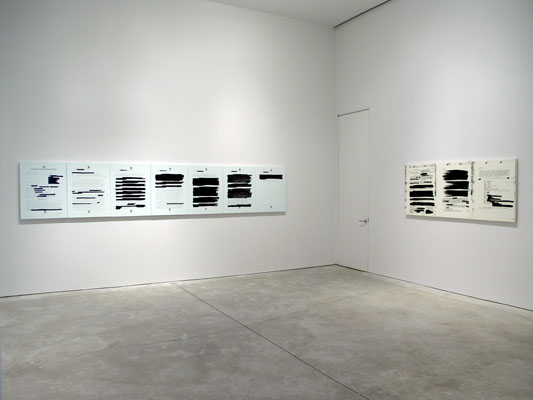
from Archive — Jenny Holzer
Coco Fusco‘s video, “Operation Atropos,” documenting the training on interrogation and resistance program she and six women went through in the woods of the Poconos, offers a political glance at the methods of physical and mental persuasion. Apart from the obviously political, the viewer realizes that this program, run by former members of the CIA, has been conceived for the private sector.
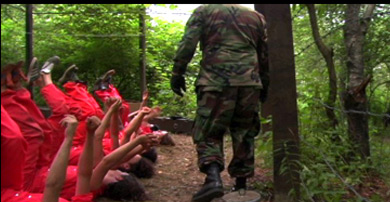
Operation Atropos
Cotter concludes his article asking, “So what kind of political art is this? It isn’t moralizing or accusatory. It’s art for a time when play-acting and politics seem to be all but indistinguishable.” They are.
It is always enormously refreshing to visit the art galleries, and to be reminded that many artists in many places, perhaps because they are faced with stark realities on a daily basis, have indeed a lot to comment. The Asian Contemporary Art Week (5/22-5/27) was one of those occasions (and still is since many galleries will continue displaying Asian art for a few more weeks.) Shilpa Gupta‘s interactive video environments at Bose Pacia offer a comment on power, militarism and imperialism. In one of the pieces the viewer sees a bucolic landscape in Kashmir and as s/he touches the screen military guards appear. Truth is indeed a fragile and many times deceiving construction.
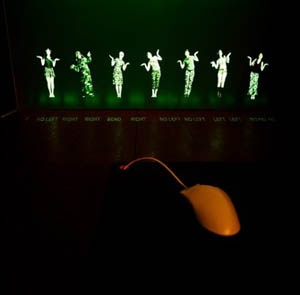
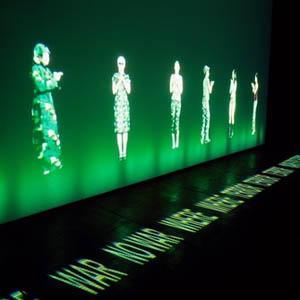
Untitled, 2005 — Shilpa Gupta
Tejal Shah‘s video installation at Thomas Erben presents the transgender community in India from within, a reality that is equally painful and celebratory. At the Sculpture Center, as part of the Grey Flags exhibition, there is a film by Apichatpong Weerasethakul the Thai filmmaker whose fresh approach to reality has taken him to use non-professional actors and improvised dialogue, offering a sober and supetcharged vision of reality in Thailand. Tilton Gallery brings together 34 contemporary Chinese artists entitled “Jiang Hu” whose literal meaning is “rivers and lakes” but that metaphorically means a place removed from the mainstream. In medieval literature it means a realm inhabited by outsiders, monks, fortune-tellers and artists who had magical powers. In the context of this exhibit that shows an interesting and disparate group, “Jiang Hu” evokes a complex reality: China an outsider within the global world.
accesselujah!!!
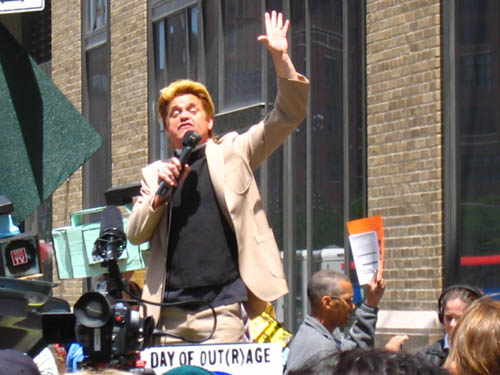
if:book took to the streets yesterday at the National Day of Out(r)age protest outside Verizon world headquarters in downtown Manhattan. Here’s Reverend Billy, a local performance artist/activist who styles himself as a televangelist (he’s sort of annoying, but entertaining in small doses). His cry: “accesselujah!”
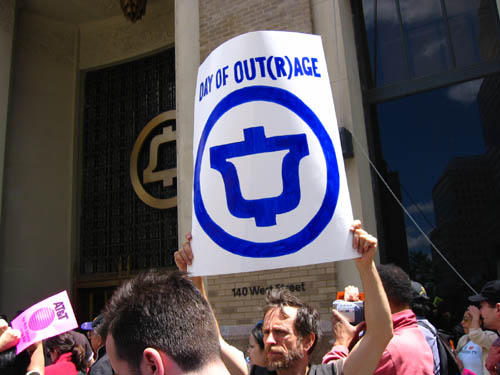
The crowd was quite small, fenced in along a single block outside the towering Verizon building. A few handfuls of grassroots media folks and other miscellanies gathered to protest the odious COPE HR5252 legislation, which threatens net neutrality and PEG (Public, Educational and Governmental) Access channels on TV. The mission is to rally one person for every telecom/cableco lobbying dollar. Judging by yesterday’s turnout, things aren’t looking so hot.
I kinda liked this sign though:
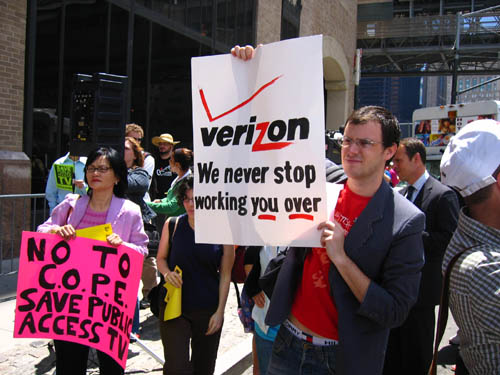
save the internet! protest today at verizon world hq

Today in Boston, Chicago, New York and San Francisco.
For New Yorkers today (some of us will be there):
National Day of Out(R)age – New York City Protest
Location: Verizon World Headquarters
140 West Street at Vesey Street
Date/Time: Wednesday, May 24th 12:30-1:30 (arrive 12:15)
ACE-23 trains to Chambers St.
Organized by the saveaccess.org Coalition with Fairness and Accuracy In Reporting (FAIR), NYC Grassroots Media Coalition, Paper Tiger TV and more!.
